Ljiljana Simić
Performance of Cell-Free Massive MIMO in Realistic Urban Propagation Environments
May 02, 2025Abstract:While UE-centric cell-free massive MIMO (CF-mMIMO) provides high and uniform throughput performance under the assumption of a uniform propagation environment modeled by the log-distance path loss channel model, the performance under a realistic urban propagation environment is not yet fully addressed. In this paper we conduct the first comparative performance study of CF-mMIMO under both the widely assumed log-distance channel model and the realistic urban propagation environment obtained via raytracing using real 3D city layouts and practical AP locations. Our results show that with the raytracing channel model, CF-mMIMO cannot achieve as high and uniform throughput performance as observed with the log-distance channel model, putting into question the attractiveness in practice of CF-mMIMO for real urban deployments.
Cross-Environment Transfer Learning for Location-Aided Beam Prediction in 5G and Beyond Millimeter-Wave Networks
Mar 18, 2025Abstract:Millimeter-wave (mm-wave) communications requirebeamforming and consequent precise beam alignmentbetween the gNodeB (gNB) and the user equipment (UE) toovercome high propagation losses. This beam alignment needs tobe constantly updated for different UE locations based on beamsweepingradio frequency measurements, leading to significantbeam management overhead. One potential solution involvesusing machine learning (ML) beam prediction algorithms thatleverage UE position information to select the serving beamwithout the overhead of beam sweeping. However, the highlysite-specific nature of mm-wave propagation means that MLmodels require training from scratch for each scenario, whichis inefficient in practice. In this paper, we propose a robustcross-environment transfer learning solution for location-aidedbeam prediction, whereby the ML model trained on a referencegNB is transferred to a target gNB by fine-tuning with a limiteddataset. Extensive simulation results based on ray-tracing in twourban environments show the effectiveness of our solution forboth inter- and intra-city model transfer. Our results show thatby training the model on a reference gNB and transferring themodel by fine-tuning with only 5% of the target gNB dataset,we can achieve 80% accuracy in predicting the best beamfor the target gNB. Importantly, our approach improves thepoor generalization accuracy of transferring the model to newenvironments without fine-tuning by around 75 percentage points.This demonstrates that transfer learning enables high predictionaccuracy while reducing the computational and training datasetcollection burden of ML-based beam prediction, making itpractical for 5G-and-beyond deployments.
Multi-Band mm-Wave Measurement Platform Towards Environment-Aware Beam Management
Apr 25, 2024Abstract:Agile beam management is key for providing seamless millimeter wave (mm-wave) connectivity given the site-specific spatio-temporal variations of the mm-wave channel. Leveraging non radio frequency (RF) sensor inputs for environment awareness, e.g. via machine learning (ML) techniques, can greatly enhance RF-based beam steering. To overcome the lack of diverse publicly available multi-modal mm-wave datasets for the design and evaluation of such novel beam steering approaches, we demonstrate our software-defined radio multi-band mm-wave measurement platform which integrates multi-modal sensors towards environment-aware beam management.
RF-Flashlight Testbed for Verification of Real-Time Geofencing of EESS Radiometers and Millimeter-Wave Ground-to-Satellite Propagation Models
Feb 28, 2024Abstract:A simple 'RF-flashlight' (or ground to satellite) interference testbed is proposed to experimentally verify real-time geofencing (RTG) for protecting passive Earth Exploration Satellite Services (EESS) radiometer measurements from 5G or 6G mm-wave transmissions, and ground to satellite propagation models used in the interference modeling of this spectrum coexistence scenario. RTG is a stronger EESS protection mechanism than the current methodology recommended by the ITU based on a worst-case interference threshold while simultaneously enabling dynamic spectrum sharing and coexistence with 5G or 6G wireless networks. Similarly, verifying more sophisticated RF propagation models that include ground topology, buildings, and non-line-of-sight paths will provide better estimates of interference than the current ITU line-of-sight model and, thus, a more reliable basis for establishing a consensus among the spectrum stakeholders.
HBF MU-MIMO with Interference-Aware Beam Pair Link Allocation for Beyond-5G mm-Wave Networks
Feb 27, 2024



Abstract:Hybrid beamforming (HBF) multi-user multiple-input multiple-output (MU-MIMO) is a key technology for unlocking the directional millimeter-wave (mm-wave) nature for spatial multiplexing beyond current codebook-based 5G-NR networks. In order to suppress co-scheduled users' interference, HBF MU-MIMO is predicated on having sufficient radio frequency chains and accurate channel state information (CSI), which can otherwise lead to performance losses due to imperfect interference cancellation. In this work, we propose IABA, a 5G-NR standard-compliant beam pair link (BPL) allocation scheme for mitigating spatial interference in practical HBF MU-MIMO networks. IABA solves the network sum throughput optimization via either a distributed or a centralized BPL allocation using dedicated CSI reference signals for candidate BPL monitoring. We present a comprehensive study of practical multi-cell mm-wave networks and demonstrate that HBF MU-MIMO without interference-aware BPL allocation experiences strong residual interference which limits the achievable network performance. Our results show that IABA offers significant performance gains over the default interference-agnostic 5G-NR BPL allocation, and even allows HBF MU-MIMO to outperform the fully digital MU-MIMO baseline, by facilitating allocation of secondary BPLs other than the strongest BPL found during initial access. We further demonstrate the scalability of IABA with increased gNB antennas and densification for beyond-5G mm-wave networks.
Will Emerging Millimeter-Wave Cellular Networks Cause Harmful Interference to Weather Satellites?
Oct 14, 2022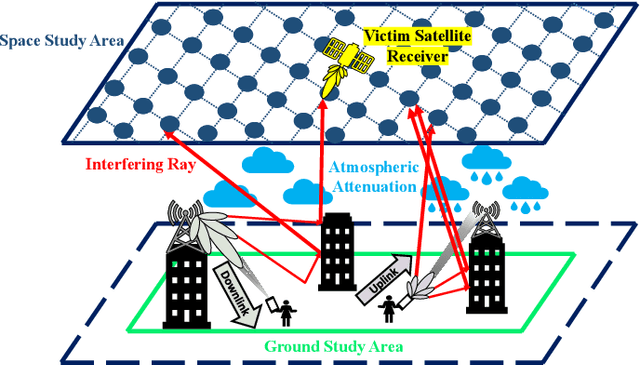
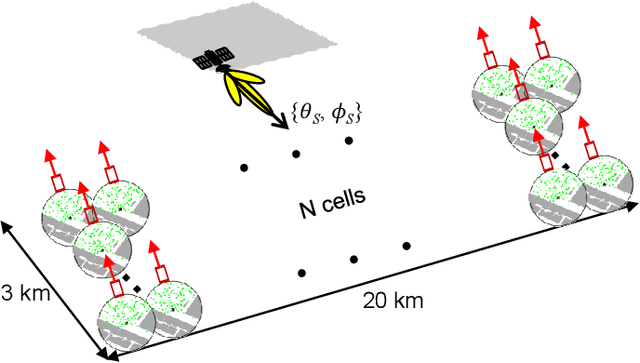
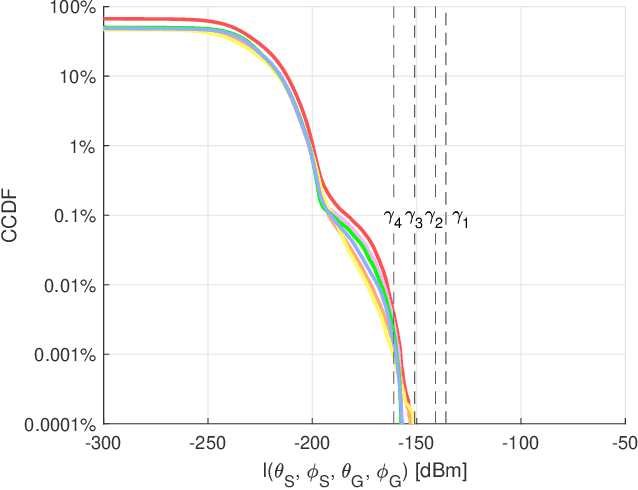
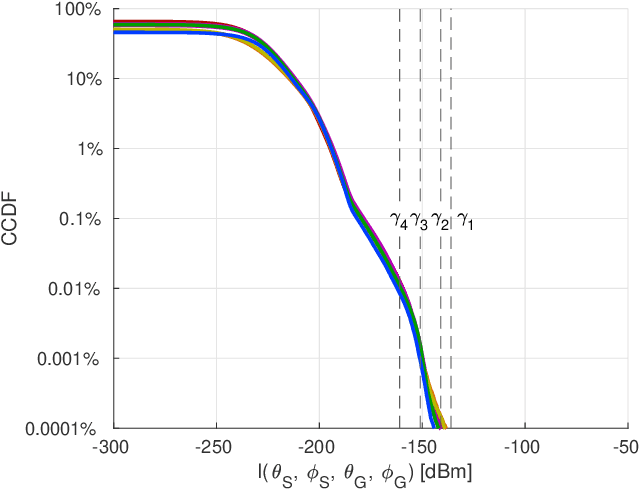
Abstract:We study whether realistic 5G mm-wave cellular networks would cause harmful out-of-band interference to weather satellites sensing in the 23.8 GHz band. We estimate uplink and downlink interference from a single interferer and a network of interferers in New York City, using real 3D building data and realistic antenna patterns. We perform detailed ray-tracing propagation simulations, for locations of the MetOp-B weather satellite and its scanning orientations and ground interferer antenna orientations for representative urban cell sites. In addition to the ITU-R threshold of -136 dBm/200 MHz, we propose an alternative set of harmful interference thresholds directly related to the sensitivity of the satellite sensor. Our results show that the 3GPP power leakage limits are sufficient to ensure that interference from a single 5G device is not harmful if considering the ITU-R threshold, but not if the weather prediction software can tolerate only very low interference levels. Importantly, aggregate interference resulting in practice from a 5G network with realistic network densities is often harmful, even considering the least conservative ITU-R threshold. Overall, our comprehensive coexistence study thus strongly suggests that additional engineering and/or regulatory solutions will be necessary to protect weather satellite passive sensing from mm-wave cellular network interference.
The Importance of Being Earnest: Performance of Modulation Classification for Real RF Signals
Sep 19, 2018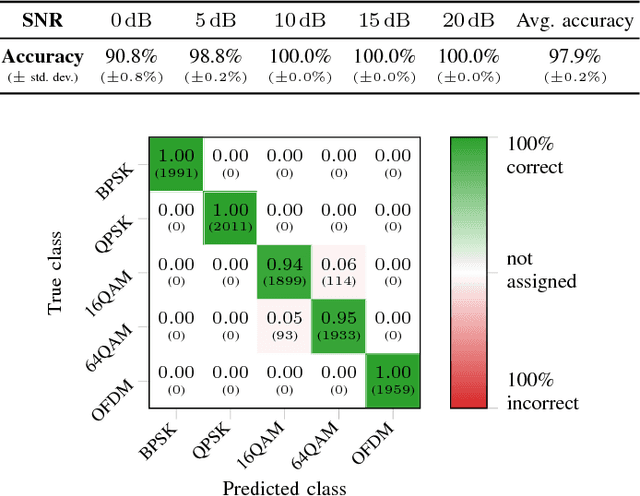
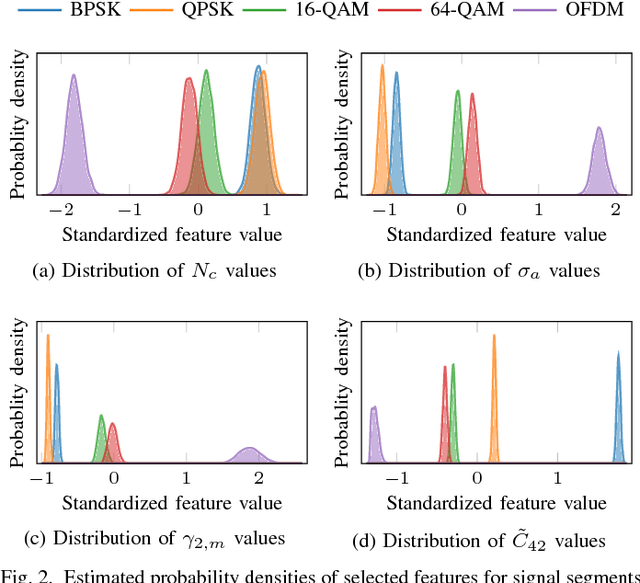

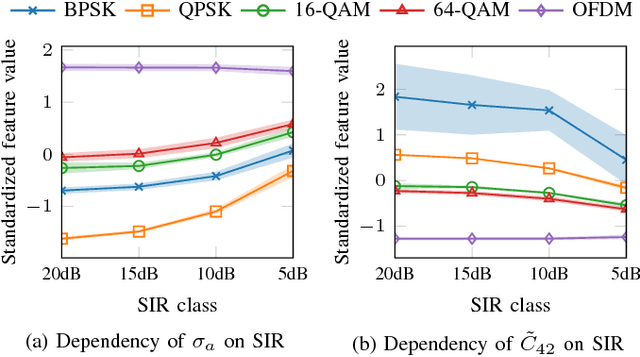
Abstract:Digital modulation classification (DMC) can be highly valuable for equipping radios with increased spectrum awareness in complex emerging wireless networks. However, as the existing literature is overwhelmingly based on theoretical or simulation results, it is unclear how well DMC performs in practice. In this paper we study the performance of DMC in real-world wireless networks, using an extensive RF signal dataset of 250,000 over-the-air transmissions with heterogeneous transceiver hardware and co-channel interference. Our results show that DMC can achieve a high classification accuracy even under the challenging real-world conditions of modulated co-channel interference and low-grade hardware. However, this only holds if the training dataset fully captures the variety of interference and hardware types in the real radio environment; otherwise, the DMC performance deteriorates significantly. Our work has two important engineering implications. First, it shows that it is not straightforward to exchange learned classifier models among dissimilar radio environments and devices in practice. Second, our analysis suggests that the key missing link for real-world deployment of DMC is designing signal features that generalize well to diverse wireless network scenarios. We are making our RF signal dataset publicly available as a step towards a unified framework for realistic DMC evaluation.
 Add to Chrome
Add to Chrome Add to Firefox
Add to Firefox Add to Edge
Add to Edge